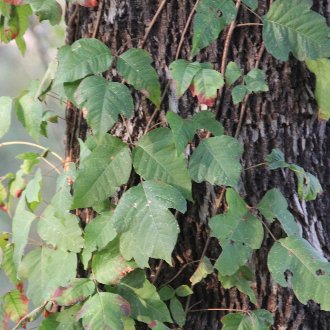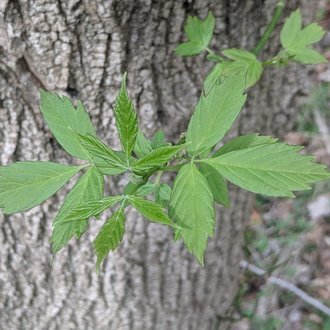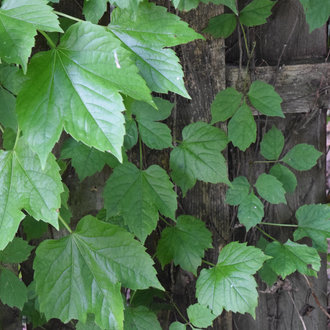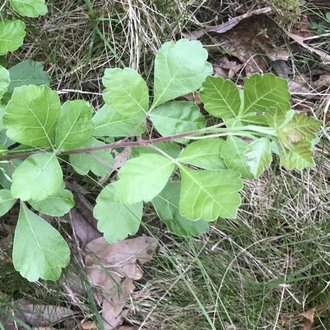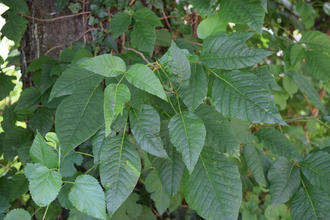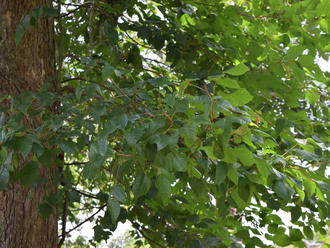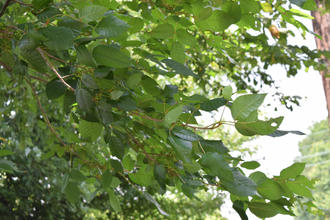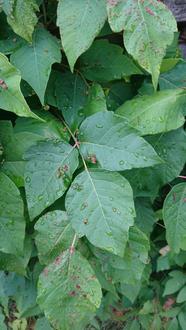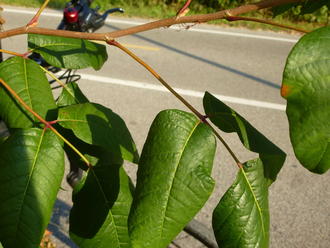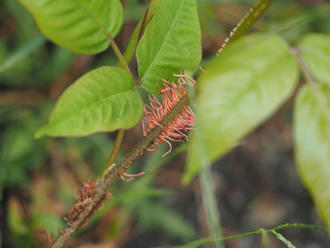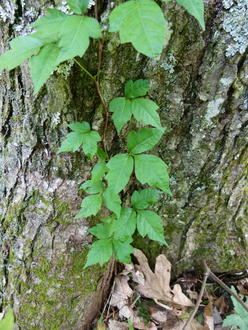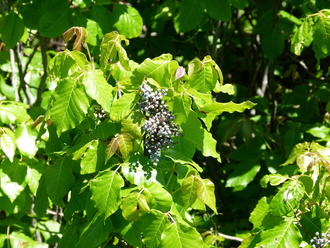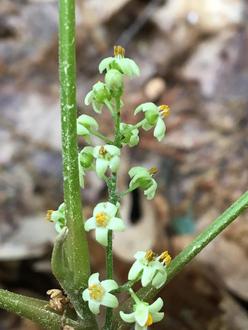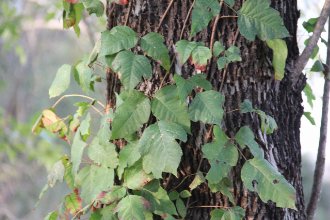Eastern Poison Ivy (Toxicodendron radicans (L.) Kuntze)
↑Summary
A perennial woody vine that can cause an unpleasant and dangerous allergic reaction following contact with its sap. Widespread and abundant in much of its range, and highly variable in appearance.
↑Range - Expand
| Legend | Color |
| Native | |
| Native or Not Present |
This tentative map is based on our own research. It may have limited data on Canada and/or Mexico, and there is some subjectivity in our assignment of plants as introduced vs. expanded. Read more in this blog post.
Although this plant occurs somewhere in each of these regions, it may only occur in a small part of some or all of them.
↑Description & Identification
This species has wildly variable characteristics in different habitats. A deciduous woody vine climbing by aerial rootlets, leading older vines to have a hairy appearance a little similar to that of English Ivy. In the absence of suitable structures to climb and sufficient light, sprawls across the ground. Sometimes forms thickets or colonies by long underground rhizomes.
Leaves alternately arranged on stems, divided into three (very rarely more) leaflets. Center leaflet on a long stalk, lateral leaflets with short or no stalk. Leaflets irregularly toothed and lobed, ranging from entire, to a few deep lobes, multiple shallow lobes, or numerous coarse teeth. Leaflets, especially those in sunlight, are often shiny.
Branches, including both those originating from the ground and from high up on a structure, usually have an irregular, curvy shape.
Young growth often has a reddish tinge to leaves and stems that usually vanishes as leaves mature.
Leaves turn bold yellow, orange, and red colors in fall.
↑Similar Plants
↑Habitat
A common plant found in a wide range of habitats, including moist to dry conditions, full sun to moderate shade, and a variety of soil types. Natural habitats include forests, especially in gaps and edges, limestone barrens, rock outcroppings, sheltered areas behind coastal sand dunes, meadows, and tallgrass prairies. Also found in anthropogenic habitats including gardens, parks, fence rows, abandoned fields, and along roadsides where it climbs telephone poles as well as trees.
Most common in woodland gaps and edges, and in forests where dead trees have allowed it to climb to reach high-light conditions. Found in open habitats as well; in grasslands it grows near the ground, under other vegetation. On rock outcroppings it can be exposed to direct sunlight. Common in floodplains and wetlands, although limited to well-drained sites spared from prolonged flooding; in these habitats, plants typically root on elevated mounds or peat mats around tree bases.
Tolerant of nearly all soil textures, including clay, sand, silt, loam, and rocky soils, and found in a wide range of soil pH (3.5 to 6.5). However, more common in nutrient-rich soils, showing a preference for greater calcium and phosphorus, and tolerant of very high phosphorus levels. Tolerates some soil salinity and salt spray, enabling it to survive in coastal habitats.
Poison ivy is present in early-successional habitats, most abundant in mid-successional stages of forests, and becomes progressively less common in later successional stages of rich forests due to heavy shading. It typically persists only as an uncommon plant in undisturbed forests. It typically colonizes abandoned agricultural land around the 3rd year.
Humans have greatly increased the habitat for this species through forest fragmentation and the creation of more edge habitat and gaps. It also benefits from logging, and is projected to benefit from global warming. Natural disturbances such as windthrow also benefit poison ivy. Plants tend to decrease in response to drought.
↑Life Cycle
Poison ivy is a long-lived rhizomatous woody plant that grows opportunistically either as a tall vine or small shrub. Its growth habit, appearance, and life cycle can be very different on different sites.
Seeds can germinate throughout much of the growing season. Seedlings usually establish better in high-light conditions, and mortality is high for heavily-shaded seedlings. Established plants, however, are able to persist for decades in lower-light conditions. Shaded plants grow slowly and do not usually flower.
Plants expand horizontally either by trailing on the surface of the ground, which is more common when there is greater light, or by underground rhizomes typically at a depth of up to 4-6 inches. Such expansion may begin in the first growing season, typically in late summer for plants germinating in the spring. Rhizome growth is often slow, proceeding only a few inches each year. Rhizomes eventually can reach quite far from the parent plant, up to 7 feet without producing aboveground shoots. Numerous fibrous roots grow from the rhizomes; such roots may reach to a depth of 12 feet.
Some seedlings often function like an herbaceous perennial in the first year or two, not growing much in the way of aboveground woody parts and investing more growth in the root system.
When aboveground stems come into contact with support such as a tree trunk, rocks, or a building, they attach and climb via aerial rootlets. Aerial rootlet growth is triggered by physical contact with a substrate, but rootlets may sometimes appear on stems not currently in contact with anything. On sunny sites without support, plants eventually grow upright, usually to about 3 feet tall, on branches that are slightly crooked or leaning. Climbing plants branch frequently, leading to branches that extend horizontally and usually descend somewhat. Climbing plants typically reach to a height of 60 feet, less frequently taller (some sources report it climbing to 150 feet.)
Each year, plants leaf out. Some branches exposed to sufficient light produce flowers, with female and male flowers borne on separate plants. Fruits are mostly consumed and distributed by birds and squirrels. Typically slightly less than half of flowering plants produce fruit. Flowering can occur as early as 3 years, but may occur much later in shade-suppressed plants.
Seeds form a persistent seed bank, but the viability of these seeds varies by site; in some habitats, most germination is from newer seeds. Many seeds are also retained through winter on the parent plants, also providing a persistent aboveground seedbank. In most of its range, cold dormancy is required before seeds germinate, but in some southerly populations (including in Florida) seeds can germinate immediately. Seeds germinate better after passing through the digestive tract of animals.
The exact longevity of this species is unknown, but individual plants have been recorded living at least 38 years, and likely can live much longer. Because of vegetative production through rhizomes, and because the original stem can die while the plant lives on elsewhere, it can be difficult to assess the age of an individual plant.
↑Control
Although this species is native to much of the eastern US, people often remove it for public health and safety reasons, as its presence can be dangerous due to its potential for causing severe contact dermatitis.
Control of this species is difficult primarily due to the risks associated with touching it. Mechanical control typically breaks plant tissues, potentially exposing a person to high levels of the sap, posing a much greater risk of a severe reaction than simply brushing up against unbroken leaves.
If attempting mechanical control, it is safest to cover up head-to-toe, wear gloves, and then uproot plants while holding them inside a bag that can be turned inside out to contain the uprooted plants. Then, shower thoroughly immediately after the work is completed, launder your clothing, and thoroughly wash any tools contacting the plant. Such control is best conducted by people not known to have a severe reaction to urushiol, as the severity of reactions tends to increase with each exposure.
This species is highly susceptible to most herbicides, including glyphosate and triclopyr, but herbicide use can be limited by the difficulty of applying herbicide to taller plants. The large extent of underground rhizomes can also confound control efforts. The best time to treat plants with herbicide is in late spring to early summer, when leaves are tender and plants are actively growing. This also tends to be the time of year when the risk of a severe reaction to exposure is highest.
When this species is growing in a park or nature preserve where people may desire to leave large, mature vines intact farther from paths, control can focus on plants growing into or near paths.
In a garden, small seedlings can be quickly killed with minimal risk by taking a long, sturdy stick and poking it to uproot the seedling and/or disrupt its root system. As with most plants, it is much easier to remove seedlings than established plants, but this difference is even stronger with this species as it tends to grow slowly in its first few years, but can develop an extensive rhizomatous root system with time.
↑Uses
Poison ivy is occasionally grown as bonsai, particularly by people from populations such as Japan with low genetic susceptibility to severe reactions to urushiol. However, there are many safer options of other woody vines that can be trained as bonsai.
↑Related Plants
There are four other Toxicodendron species native to North America and more globally. Of these, poison sumac (Toxicodendron vernix), Atlantic poison oak (Toxicodendron pubescens), and western poison ivy (Toxicodendron rydbergii) overlap in range.
There are numerous other plants of the Anacardioideae subfamily of the Anacardiaceae (Cashew or Sumac) family.
↑Links & External Resources
• Toxicodendron radicans (Poison Ivy) | Illinois Wildflowers (About This Site)
• Toxicodendron radicans (Eastern Poison Ivy) | USDA PLANTS Database (About This Site)
• Toxicodendron radicans | Go Botany (About This Site)
• Toxicodendron radicans (Poison Ivy) | Missouri Botanical Garden Plant Finder (About This Site)
• Poison-Ivy | Virginia Tech Dendrology Factsheets (About This Site)
• Toxicodendron radicans | Biota of North America Project (BONAP) (About This Site)
• Toxicodendron radicans | NatureServe Explorer (About This Site)
• Toxicodendron radicans | Missouri Plants (About This Site)
• Eastern Poison Ivy | Maryland Biodiversity Project (About This Site)
• Toxicodendron radicans (L.) Kuntze var. pubens (Engelm. ex S. Wats.) Reveal (Poison Ivy) | Digital Atlas of the Virginia Flora (About This Site)
• Toxicodendron radicans (L.) Kuntze var. radicans (Poison Ivy, Eastern Poison Ivy) | Digital Atlas of the Virginia Flora (About This Site)
• Toxicodendron radicans (L.) Kuntze var. negundo (Greene) Reveal (Midwestern Poison Ivy) | Digital Atlas of the Virginia Flora (About This Site)



